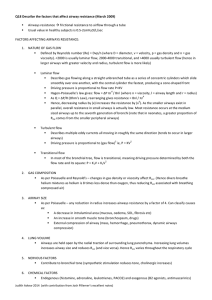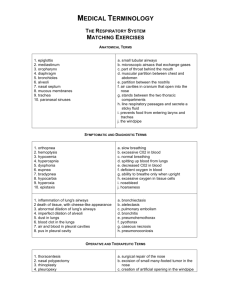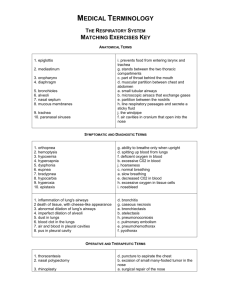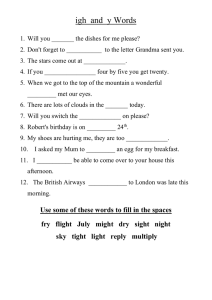Airways Resistance and Airflow through the
advertisement
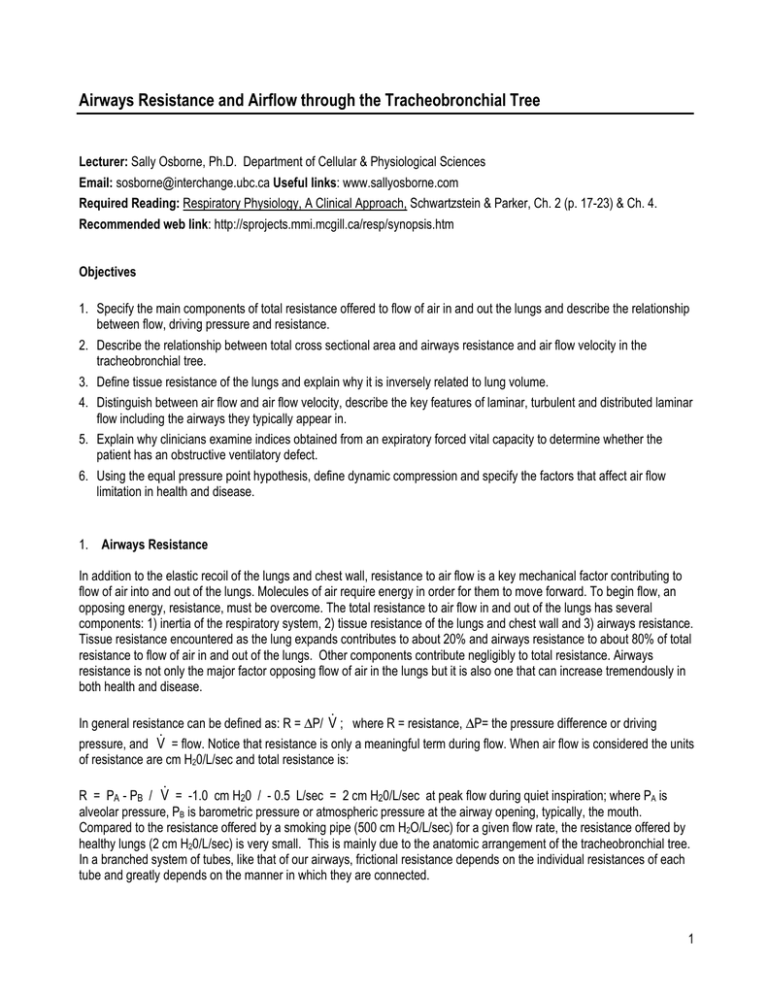
Airways Resistance and Airflow through the Tracheobronchial Tree Lecturer: Sally Osborne, Ph.D. Department of Cellular & Physiological Sciences Email: sosborne@interchange.ubc.ca Useful links: www.sallyosborne.com Required Reading: Respiratory Physiology, A Clinical Approach, Schwartzstein & Parker, Ch. 2 (p. 17-23) & Ch. 4. Recommended web link: http://sprojects.mmi.mcgill.ca/resp/synopsis.htm Objectives 1. Specify the main components of total resistance offered to flow of air in and out the lungs and describe the relationship between flow, driving pressure and resistance. 2. Describe the relationship between total cross sectional area and airways resistance and air flow velocity in the tracheobronchial tree. 3. Define tissue resistance of the lungs and explain why it is inversely related to lung volume. 4. Distinguish between air flow and air flow velocity, describe the key features of laminar, turbulent and distributed laminar flow including the airways they typically appear in. 5. Explain why clinicians examine indices obtained from an expiratory forced vital capacity to determine whether the patient has an obstructive ventilatory defect. 6. Using the equal pressure point hypothesis, define dynamic compression and specify the factors that affect air flow limitation in health and disease. 1. Airways Resistance In addition to the elastic recoil of the lungs and chest wall, resistance to air flow is a key mechanical factor contributing to flow of air into and out of the lungs. Molecules of air require energy in order for them to move forward. To begin flow, an opposing energy, resistance, must be overcome. The total resistance to air flow in and out of the lungs has several components: 1) inertia of the respiratory system, 2) tissue resistance of the lungs and chest wall and 3) airways resistance. Tissue resistance encountered as the lung expands contributes to about 20% and airways resistance to about 80% of total resistance to flow of air in and out of the lungs. Other components contribute negligibly to total resistance. Airways resistance is not only the major factor opposing flow of air in the lungs but it is also one that can increase tremendously in both health and disease. In general resistance can be defined as: R = ∆P/ V& ; where R = resistance, ∆P= the pressure difference or driving pressure, and V& = flow. Notice that resistance is only a meaningful term during flow. When air flow is considered the units of resistance are cm H20/L/sec and total resistance is: R = PA - PB / V& = -1.0 cm H20 / - 0.5 L/sec = 2 cm H20/L/sec at peak flow during quiet inspiration; where PA is alveolar pressure, PB is barometric pressure or atmospheric pressure at the airway opening, typically, the mouth. Compared to the resistance offered by a smoking pipe (500 cm H2O/L/sec) for a given flow rate, the resistance offered by healthy lungs (2 cm H20/L/sec) is very small. This is mainly due to the anatomic arrangement of the tracheobronchial tree. In a branched system of tubes, like that of our airways, frictional resistance depends on the individual resistances of each tube and greatly depends on the manner in which they are connected. 1 A branching system can be connected in two ways: 1) In series: Rtotal= R1 + R2 + R3 etc… where the total resistance of the system is equal to the sum of each individual resistance. 2) In parallel: 1/Rtotal = 1/R1 + 1/R2 + 1/R3 etc... where the total resistance of the system is equal to less than any individual single resistance. If you had four identical resistances set up in parallel, the total resistance of the system would be ¼ of any single resistance; if you had 5 identical resistances, the total resistance is 1/5 of any single resistance etc... 2. Total Cross Sectional Area & Resistance in a System of Branching Tubes Resistance in a single tube is inversely related to the radius of the tube to 4th power, R α 1/r4. Therefore the greater the radius, diameter, or cross sectional area of the tube, the less the resistance. Consider how our airways branch from the trachea to the alveoli. At each new branch point, the daughter airways that arise from that same branch point belong to the same generation. The airways of the same generation tend to be of the same size. The number of branches increases as one moves from the trachea to the alveoli, and the radius, diameter and cross section of the individual airways gets progressively smaller. However the total cross sectional area of the branching airways arranged in parallel increases and overall resistance is decreased. Recall that if you have 5 identical resistances in parallel, the total resistance would be 1/5 of any single resistance. Now imagine you have 20, 30 or 100 parallel resistance. The total resistance would then be 1/100 of any single resistance. At this distal point in the airways, the resistances become almost insignificant. Most of the overall airway resistance comes from the upper airways and generations 0 through 6 where total cross sectional area of the generation is relatively small. The enormous expansion of the sum of the cross sectional area of parallel airways from about 2.5 cm2 in the trachea to 180 cm2 at about generation 16, the end of the conducting zone, effects not only airways resistance but it also has impact on the velocity of air flow. Velocity of air through a series of branching tubes arranged in parallel is similar to resistance, in that both are inversely related to the total cross sectional area of the tubes. [For a more thorough understanding of why velocity is inversely related to cross sectional area read about the Bernoullie’s Principle in your Pulmonary Physiology textbook by Shwarztein & Parker pages 69-70 and see the following web link: http://sprojects.mmi.mcgill.ca/resp/bernoulli_effect.htm 2 An important outcome of this relationship is that during inspiration, if a single large gulp of air flows from the trachea to the distal airways, the air velocity decelerates. About 96% of the lung volume is contained within the respiratory zone, a final few millimeters of the airways, distal to generation 16. Here convective flow ceases and diffusion is the main mode of gas movement in the gas exchange zone of the lungs. Hence, the parallel arrangement of the tracheobronchial tree optimizes the conflicting demands for having 1) a small airway volume that does not contribute to gas exchange (the conducting zone) and 2) a small resistance to accommodate the flow of large amounts of air into the respiratory zone. Conversely, during expiration when air flows from the distal airways to the trachea, the air velocity accelerates, allowing air to exit through the relatively small airway volume of the conducting zone in reasonable time. 3. Lung Tissue Resistance Lung tissue resistance refers to the resistance offered by lung tissue as it expands. Lung tissue resistance varies with lung volume. At high lung volumes, the alveoli are more distended and the elastic recoil tension in their walls is higher. In our lungs, airways are surrounded by and attached to alveoli. The airways are thus pulled open by the high tension in the distended alveolar walls of their neighboring airways. As lung volume increases, the tension in the alveolar attachments to the airways increases, pulling the airways open outwards. This increases airway diameter and decreases resistance. At lower lung volumes approaching residual volume, the elastic recoil tension in the alveolar wall is less, and thus the airways are narrower and contribute more to airway resistance. Some airways may even begin to close at such low volumes especially at the bottom of the lungs where the lungs are less expanded. 4. Air Flow Flow rate is defined as the amount of fluid (ml) moving per second [flow rate = ml/sec]. Do not confuse flow rate with flow velocity, which is the distance fluid travels in one second [Velocity = flow rate / cross-sectional area of the tube (cm2) = cm/sec]. Air is a fluid and follows the principles of fluid dynamics as it moves in and out of the lungs. In the airways, flow will occur when a pressure difference exists between one point along the airway and another, from higher pressure to a lower pressure. Flow can exist in three patterns described below: Laminar Flow is streamlined such that the fluid at the center of the tube moves the fastest. In Latin, laminae means layers and laminar flow refers to circular layers of fluid movement with the fastest being in the center to the slowest at the walls of the tube. Therefore, laminar flow has a parabolic velocity profile. During laminar flow the relationship between driving pressure and flow is linear, ∆P α V& . with an increase in driving pressure, flow will increase proportionally. Flow in small airways (diameter < 2mm) is laminar, silent and slow. Turbulent Flow results in fluid flow in both axial and radial direction and the velocity of the fluid is, on average, the same everywhere in the tube. Therefore, turbulent 3 flow has a blunt velocity profile. The radial component of turbulent flow constantly impacts the walls of the tube and consumes energy, therefore, a higher pressure difference is needed to maintain a given flow rate. The relationship between driving pressure and flow in turbulent flow is alinear: ∆Pα V& 2. In order to double the flow under turbulent conditions, the pressure difference must be more than doubled. In the large airways such as the trachea air flow is turbulent, fast and noisy. The relationship between flow and driving pressure differs in laminar and turbulent flow. There is a linear relationship between pressure and flow under laminar conditions and a non-linear relationship under turbulent conditions. Increasing driving pressure results in greater laminar flow compared to turbulent flow. This is because with turbulent flow regimes some of the driving pressure is expended in generating radial flow. Disturbed Laminar Flow is a combination of laminar and localized turbulent fluid movements referred to as eddies. Eddies occur where the tube either narrows, branches, or where there are irregularities in the tube surface. This type of flow represents a mix between laminar and turbulent flow and is present in the majority of airways. 5. Measuring Flow During Maximal Expiration: A Clinical Tool To Index Airflow Limitation During expiration, healthy individuals can force air out of their lungs at greater flow rates the more effort they put into contracting their expiratory muscles. However, when a maximal effort is exerted to exhale, this effort affects the flow rate at high lung volumes and not flow rate at lower lung volumes. During maximal expiratory efforts, flow rate at low lung volumes is independent of effort due to air flow limitation. In the clinical setting, patients are routinely asked to perform a forced expiratory vital capacity maneuver, emptying their lungs as rapidly and forcefully as possible from maximal inspiration to maximal expiration to determine the degree of air flow limitation. The amount of air expired in one second, FEV1, and maximal flow rates during this maneuver provide convenient measures to determine whether there is limitation to flow of air during forced expiration beyond what is normally present in healthy individuals. (more about this in the spirometry laboratory and demonstration lecture). 4 6. Dynamic Compression & Determinants of Maximal Expiratory Flow During a forced expiratory maneuver, the forceful contraction of the expiratory muscles squeezes the chest wall and its contents giving rise to 1) a rise in intrapleural pressures to very high positive values (as high as 120 cm H20) and 2) a rise in alveolar pressure that is equivalent to the sum of intrapleural pressure and the elastic recoil pressure of the lung . The rise in alveolar pressure sets the driving pressure for flow of air out of the lungs (figure A). As the air flows out of the lungs, lung volume is decreased and the pressure in the airways subsides (figure B). In a dynamic situation like this, if there are points along the airway where the intrapleural pressure surrounding the airway is greater than the pressure in the airway, the airway may narrow (compress) and there will be limitation to airflow. Along the airways, points at which the intrapleural pressure is equivalent to airway pressure are called equal pressure point. Dynamic compression and narrowing of the airway can develop close to the equal pressure point where intrapleural pressure exceeds airway pressure AND where there is inadequate cartilaginous support or traction provided by neighboring alveoli. As the lungs continue emptying, the equal pressure point moves down the airways from larger to smaller airways towards the alveoli, increasing the dynamic compression of the airways and ultimately resulting in airway collapse or closure. Fig. A Fig. B Factors that affect airflow limitation include: 1) Lung compliance • • A decrease in elastic recoil of the lungs (either because of low lung volume or due to emphysema) reduces its contribution to a greater pressure in the airway relative to intrapleural pressure resulting in greater dynamic compression. A decrease in elastic recoil of the lungs results in less traction on neighboring airways and greater dynamic compression 2) Airways resistance • The greater the resistive drop in pressure along the airway from the alveolus to the equal pressure point, the sooner the development of an equal pressure point and the greater the dynamic compression. 5
